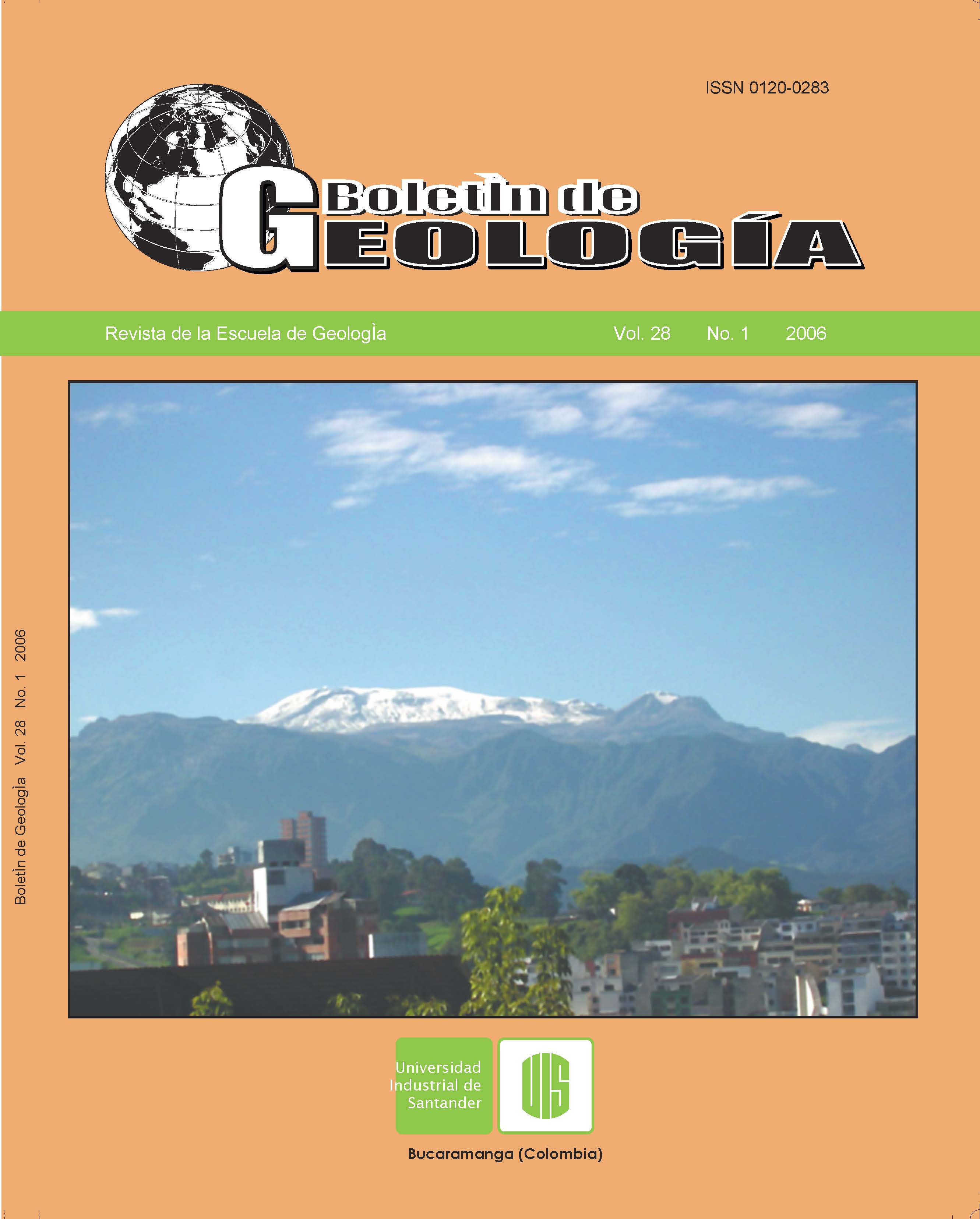C, O, Sr ISOTOPE AND RARE EARTH ELEMENTS (REE) STUDY IN SEDIMENTARY CRETACEOUSROCKS FROM THE EAST CORDILLERA (DPTO. DE SANTANDER, COLOMBIA):PALEOHYDROGEOLOGICAL IMPLICATIONS
Published 2013-07-18
How to Cite
Abstract
The study of calcareous materials (from rocks and veins) of the Cretaceous Rosablanca, Paja and Tablazo Formationsoutcropping to the South of the Dpto. Santander allowed the distinction of two carbonates groups on the basis of theirisotopic (δ18O y δ13C) signature: a) Carbonates type I: with a range of δ18O values between 20.15‰ and 22.28‰ and relativityhomogeneous δ13C values -1.1‰<δ13C<0.9‰; b) Carbonates type II: with δ18O values between 20.31‰ and 21.60‰, and1.8‰ <δ13C< 5.8‰ values. Some differences in the isotopic signature of calcareous rocks and veins could indicate theinfluence of aloctonous waters. Geochemical data analysis of REE of the Cretaceous Paja and Rosablanca Formations, provethe marine features of these two units, as indicated by the negative Eu and Ce anomalies. The absence of a negative anomalyin Eu of the K-mica agregates from veins, is the result of the oxic conditions at the time of the hydrothermal event. The Srgeochemistry (87Sr/86Sr) in the studied samples, indicates a mixed source derived from both: continental and marine. On theother hand, the Sr of circulating waters through fractured rocks, show that it was derived exclusively from theses host rocks.
Key words: Departamento de Santander, carbonates, stable isotopes, fluids, REE and Sr geochemistry.
Downloads
References
Branquet, Y.; Cheilletz, A., Giuliani, G., Laumonier, B.,Blanco, O. (1999) Fluidized hydrothermal breccia indilatant faults during thrusting: Colombia emerald deposits.pp. 183-196. In: Fractures, Fluid Flow and Mineralization.McCaffrey, K. The Geological Society eds. London
Branquet, Y., Cheilletz, A., Cobbold, P., Baby, P.,Laumonier, B., Giuliani, G., (2002). Andean deformationand rift invertion, eastern edge of Cordillera Oriental(Guateque-Medina area), Colombia. Journal of SouthAmerica Earth Sciences 15, pp. 391-407
Burke, W, H., Denison, R. E., Hetherington, E. A.,Koepnick, R. B., Nelson, H. F., Otto, J. B., (1982).Variation of seawater 87Sr/86Sr throughout Phanerozoictime. Geology. Vol. 10, pp. 516-519
Cheilletz, A., Féraud, G., Giuliani, G., Rodriguez, C. T.,(1994). Time-Pressure and Temperature Constraints onthe Formation of Colombian Emeralds: An 40Ar/39Ar Lasermicroprobe and Fluid Inclusion Study. EconomicGeology. Vol. 89, pp. 361-380.
Cheilletz, A., Giuliani, G., Zimmermann., Ribeiro-Althoff,A., (1995): Ages, geochemical signatures and origin ofBrazilian and Colombian emerald deposits: a magmaticversus sedimentary model. Mineral Deposits, Pašava,Kribek and Zak (eds), Rotterdam, pp. 569-572
Cheilletz, A., G., Giuliani, (1996). The genesis ofColombian emeralds: a restatement. MineraliumDeposita, Vol. 31, pp. 359-364
Denison, R. E., Koepnick, R. B., Burke, W. H.,Hetherington, E. A., Fletcher, A., (1997). Constructionof the Silurian and Devonian seawater 87Sr/ 86Sr curve.Chemical Geology. 140, pp. 109-121
Dickin, A. P., (1995). Radiogenic isotope Geology.Cambridge University Press. U.K. 490 p.Faure, G., (1986). Principles of Isotope Geology(Segunda edición), Edit. John Wiley & Sons. 589 p
Faure, G., Mensing, T. (2005). Isotopes. Principles andApplicatios. Vol. IV. Edit. John Wiley & Sons. 896 pag.Friedman, I.; O’Neil, J. R., (1977). Compilation of stableisotope fractionation factors of geochemical interest.USGS profe. Paper 440-KK
Folk, R. L., (1974) Petrology of sedimentary rocks.Hemphill Publishing Company. Austin Texas.182 p.Giménez, J., Taberner, C., (1997). Carbonatos de origensedimentario y diagenético. In: Atlas de asociacionesminerales en lámina delgada. Melgarejo, J. Universitat deBarcelona (edists)
